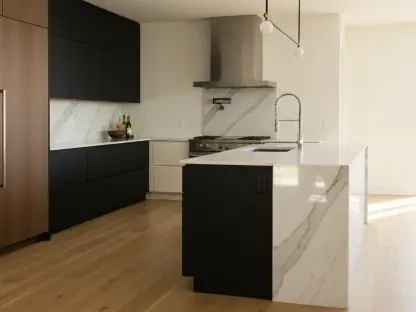Imagine a workplace where the environment automatically adjusts to save energy while ensuring that employees feel comfortable, focused, and productive—a reality made possible by smart building technology, which is revolutionizing how facilities are managed. By integrating advanced tools like the Internet of Things (IoT), buildings can achieve significant energy savings and create healthier indoor spaces for occupants. Industry experts highlight that these dual benefits are not only achievable but also financially viable, often with minimal additional investment. The convergence of energy efficiency and occupant well-being represents a transformative shift in building design and operation, addressing two critical challenges of modern infrastructure. This article delves into the mechanisms behind these advancements, exploring how intelligent systems are reshaping environments to balance cost savings with human-centric design, and why this approach is becoming an essential standard for facility managers across diverse sectors.
Revolutionizing Energy Efficiency with Smart Technology
Harnessing IoT for Energy Optimization
Smart building technology offers a powerful solution to one of the most pressing issues in facility management: energy consumption. By deploying IoT-enabled sensors, buildings can dynamically monitor and adjust systems like heating, ventilation, and air conditioning based on real-time occupancy and usage patterns. For instance, unoccupied spaces can have their temperature settings lowered automatically, preventing unnecessary energy waste. Experts note that such implementations can lead to performance improvements of up to 20%, a figure that translates into substantial cost reductions. The financial appeal is further underscored by the rapid return on investment, often realized within just a year of installation. This efficiency isn’t merely about cutting bills; it’s about creating a sustainable framework where resources are used judiciously, aligning with broader environmental goals while maintaining operational budgets.
Scaling Energy Savings Across Diverse Settings
Beyond traditional office environments, the principles of smart energy management are proving adaptable to unexpected sectors. Consider agricultural facilities in Europe, where IoT tools are optimizing energy use to enhance crop growth and livestock productivity. These systems adjust environmental controls to minimize waste while maximizing output, demonstrating the versatility of the technology. The same sensors and data-driven approaches can be tailored to human-centric spaces, ensuring that energy efficiency doesn’t come at the expense of comfort. This scalability highlights a key advantage: once the infrastructure is in place, it can serve multiple purposes with little added cost. Facility managers across industries are beginning to recognize that intelligent systems provide a blueprint for sustainable operations, whether the setting is a corporate high-rise or a rural farmstead. The adaptability of these solutions suggests a future where energy optimization becomes a universal standard, regardless of the building’s primary function.
Enhancing Occupant Well-Being Through Intelligent Design
Optimizing Indoor Environments for Productivity
The impact of smart technology on occupant well-being is as significant as its effect on energy efficiency, though the benefits are often less immediately measurable in financial terms. IoT systems can fine-tune indoor conditions such as air quality, lighting, and temperature to create environments that support health and productivity. Research consistently shows that factors like balanced carbon dioxide levels and high-quality lighting can enhance employee performance and satisfaction. Industry leaders suggest that even a modest 10% boost in productivity due to improved workspace conditions can yield economic returns within a few quarters. This human-centric approach transforms buildings from mere structures into ecosystems that actively contribute to the well-being of those within them, prioritizing comfort alongside operational goals and setting a new benchmark for workplace design.
Innovative Sound Management for Focus and Privacy
One often-overlooked aspect of well-being is the role of sound in shaping a productive environment, particularly in open office layouts. While complete noise cancellation remains impractical due to multiple sound sources, smart technology offers an alternative through sound masking. Using ceiling diffusers to emit brown noise, this method creates localized zones where conversations are muffled, reducing distractions and enhancing focus or privacy. Occupants can activate these sound pockets at their discretion, much like they might adjust lighting or temperature settings. This personalized control over environmental factors represents a nuanced application of IoT, addressing specific challenges that impact daily work experiences. By mitigating auditory disruptions, buildings can foster a sense of calm and concentration, proving that well-being extends beyond physical comfort to include sensory considerations.
Building a Future of Integrated Solutions
Seamless Systems for Dual Benefits
The true potential of smart building technology lies in its ability to address energy efficiency and occupant well-being simultaneously through integrated systems. Once a network of sensors and wireless tools is established, it can be leveraged for multiple objectives without significant additional expense. This dual-purpose functionality eliminates the need to choose between cost savings and human comfort, creating a data-driven framework for innovative management. The seamless nature of these systems allows for real-time adjustments and long-term planning, ensuring that buildings remain adaptable to changing needs. As more facilities adopt this approach, the industry is witnessing a shift toward holistic design, where intelligent infrastructure becomes the backbone of both financial pragmatism and occupant-focused environments, redefining what it means to operate a modern facility.
Reflecting on Past Progress for Future Action
Looking back, the journey of smart building technology reveals a remarkable synergy between economic and human benefits that has reshaped facility management. The rapid financial returns from energy savings, coupled with productivity gains from enhanced indoor conditions, demonstrate a clear path forward for building operators. Innovative applications like sound masking tackle nuanced workplace challenges, while the adaptability of IoT systems across diverse settings underscores their universal value. Moving ahead, the focus should shift to accelerating adoption through education and investment in scalable infrastructure. Stakeholders must prioritize integrating these intelligent solutions into both new constructions and retrofits, ensuring that the momentum gained continues to build. By championing data-driven design, the industry can establish a standard where energy efficiency and well-being are not competing priorities but complementary outcomes of a unified, forward-thinking strategy.









